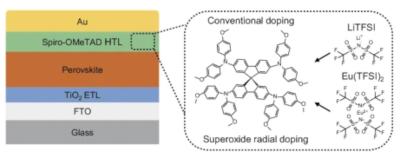Researchers from China's Northwestern Polytechnical University, The Hong Kong University of Science and Technology, and Spain's Technical University of Madrid have developed a new lithium-free doping strategy to fabricate spiro-OMeTAD-based hole transport layers (HTLs) for applications in perovskite solar cell. A PV device built with a lithium salt-doped HTL achieved an efficiency of 25.45%.
Schematic illustration of a n-i-p PSC with spiro-OMeTAD HTLs doped by LiTFSI or Eu(TFSI)2. Image from Nature Communications
The team's lithium-free doping strategy to fabricate a perovskite solar cell is based on a metal-free hole transport layer (HTL) made of spiro-OMeTAd that reportedly offers remarkable efficiency and stability levels. The research team explained that spiro-OMeTAD for perovskite cell applications is usually doped with a compound known as lithium bis(trifluoromethanesulfonyl)imide (LiTFSI) to enhance hole extraction and conductivity. This kind of doping, however, requires time-intensive air-oxidization for 24 hours, which reportedly represents an obstacle to the commercial production of perovskite PV devices.
“The inadequate doping efficacy of this post-treatment process may lead to the retention of unreacted reactants and/or detrimental by-products in the doped spiro-OMeTAD layer, thereby negatively affecting the device efficiency,” the academics stated in their work. “Furthermore, a significant challenge that restricts their practical application is the trade-off between high efficiency and stability.”
To solve this issue, the team used a salt known as Eu(TFSI) for the doping of spiro-OMeTAD, which can generate oxygen (O2) and facilitate the pre-oxidation of spiro-OMeTAd. “In stark contrast to conventional LiTFSI doping with air exposure, O2-derived spiro-OMeTAD HTLs can instantly obtain high conductivity and ideal work function without requiring post-treatments”, the scientists added.
Adopting this doping strategy, the researchers built a solar cell with a substrate made of glass and fluorine-doped tin oxide (FTO), an electron transport layer (ETL) based on titanium oxide (TIO2), a perovskite absorber, the proposed HTL doped with Eu(TFSI), and a gold (Au) metal contact.
Tested under standard illumination conditions under reverse scanning, the device achieved a power conversion efficiency of 25.45%, an open-circuit voltage of 1.210 V, a short-circuit current density of 25.41 mA cm2, and a fill factor of 82.50%. A reference LiTFSI-doped cell with the same architecture reached an efficiency of only 23.19%.
“Additionally, the O2-derived devices deliver a stabilized power output (SPO) of 25.22% for 100 s, while the SPO of LiTFSI-doped devices is just stabilized at 22.48%,” the scientists further explained, noting that the cell was also able to retain 90% of its initial efficiency after 1000 h of operation.
The device was then used to build a 6 cm x 6 cm perovskite solar module that achieved an efficiency of 20.35%. The team said that this result shows the effectiveness of the new doping strategy regardless of the size of the devices.
“In perovskite solar cells with post-oxidation-free or Li-free spiro-OMeTAD HTLs, the present O2-deriving work ranks among the highest in terms of both efficiency and stability,” the team concluded.




